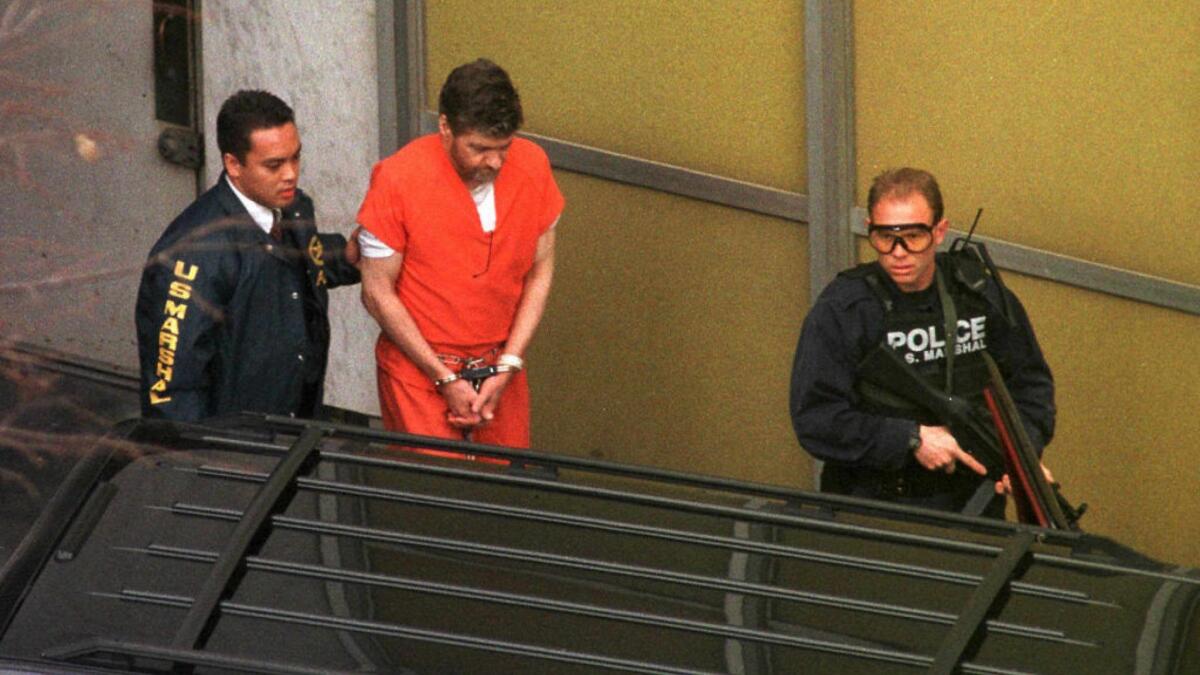Technology helps catch serial bombers, but ego is their biggest vulnerability

- Share via
It took authorities 17 years to find the Unabomber.
It took them 19 days to find the Austin bomber.
The difference largely boiled down to technology. Smartphones and surveillance cameras played an instrumental role in tracking down Mark Anthony Conditt, who officials said was responsible for the string of attacks this month that terrorized Austin, Texas.
He was seen on video in two FedEx package shops. Authorities identified cellphone data that placed him at the site of the explosions. They tracked his internet searches and receipts. On Wednesday, authorities followed him from his motel, where he ultimately pulled over and blew himself up in his car.
Such technology wasn’t around when the Unabomber, Ted Kacyynski, was sending his bombs through the mail between 1978 and 1995. Ironically — today at least — his bombings, which killed three people and injured more than 20, were intended as a protest against technology.
Experts said what hasn’t changed since those days is the key vulnerability of most bombers: a huge ego.
They will find a way to be visible, according to Mike Rustigan, a professor emeritus of criminal justice at San Jose State University.
“Given more people with smart phones and given there are surveillance cameras most everywhere, you would think they would have a deterrent effect,” Rustigan said. “But the nature of these serial bombers — like Ted Kaczynski — is they think they can beat the system. It’s their monstrous egos that enable them to feel they’re above the law and they’re the one who will never be caught.”
But days after Timothy McVeigh blew up the federal building in Oklahoma City in 1995, Kaczynski delivered a bomb near Sacramento in what Rustigan characterized as a display of one-upmanship. Then Kaczynski demanded the New York Times and the Washington Post publish his 35,000-word manifesto — which they did.
That led Kaczynski’s brother to recognize the writing style, which in turn led to authorities moving their search to a new location: Montana.
Had the manifesto not been published, Rustigan said, it’s possible that he could have kept bombing without getting caught.
“It’s very important for them to be recognized and to get TV coverage and print coverage,” Rustigan said. “You can see a tremendous level of grandiosity and egomania with all of these bombers, regardless of their typology.”
Technology is a double-edged sword to the bombers — it makes notoriety easier to attain, but capture more likely as well.
Enzo Yaksic, who runs Northeastern University’s Atypical Homicide Research Group, said serial killers are enamored of the ability to control a community, and also hope to garner sympathies from those who might admire or commiserate with them.
That was the case with Eric Rudolph, who killed two people and injured hundreds in bombings between 1996 and 1998 — including the one at the Olympics in Atlanta and an abortion clinic in Alabama.
During that manhunt, he hid in the forests outside of Murphy, a small town in North Carolina that seemed to share his anti-gay, anti-abortion beliefs and may have helped shield him.
According to the Christian Science Monitor, a sign outside town read: “Pray for Eric Rudolph.”
He evaded capture for five years before being spotted by a rookie police officer. After his arrest, Rudolph signed autographs of his “wanted” posters for sheriff’s deputies.
During his sentencing in 2005, he was defiant, winking at prosecutors. In an 11-page statement released by his lawyers, he compared himself to a patriot in the Revolutionary War.
“Abortion is murder,” he wrote. “And when the regime in Washington legalized, sanctioned and legitimized this practice, they forfeited their legitimacy and moral authority to govern.”
Yaksic said it is unclear how much sooner Rudolph could’ve been caught in a digital world.
“Advances in technology have altered the landscape of multiple-murder as the decline in serial homicide since the 1990s directly parallels the near ubiquity of surveillance technology, cellular phone and Internet use,” Yaksic wrote in an email. “Law enforcement’s ease of tapping into cellular phone tracking records, their callback of Internet search histories and receipt of surveillance videos have greatly aided many modern day investigations by providing the whereabouts of potential suspects and the outlines of future plans.”
Bill Jonkey, a retired special agent bomb technician with the FBI, said the cell phone often plays a key role in bringing a case together — but only after the suspect is identified. Making that identification is much easier now, with surveillance cameras most everywhere.
He worked the bombing of Harvey’s Hotel and Casino near Lake Tahoe in 1980 and didn’t have the benefit of today’s high-tech tracking devices. He said it was eventually a tip and a name he got that led him to the bomber, John Birges.
Then, as they built the case, he had to track him down — without the benefit of cell phone triangulation.
“During the latter part of the investigation, I moved down to Fresno and, toward the end before we arrested him, my job was to contact him every single day for probably about a month,” Jonkey said. “Sometimes he would invite me in and he’d say, ‘Well, if I was the bomber, I’d have done this or that.’ You could just tell he wanted to tell me so bad he’d done it.”
“He had a huge ego.”
To read this article in Spanish click here
Twitter: @davemontero
More to Read
Sign up for Essential California
The most important California stories and recommendations in your inbox every morning.
You may occasionally receive promotional content from the Los Angeles Times.














